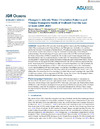Please use this identifier to cite or link to this item:
https://accedacris.ulpgc.es/jspui/handle/10553/76682
| Title: | Changes in Atlantic water circulation patterns and volume transports north of Svalbard over the last 12 years (2008‐2020) | Authors: | Athanase, M. Provost, C. Artana , C. Pérez-Hernández, M. D. Sennéchael, N. Bertosio, Cé. Garric G. Lellouche J.M. Prandi P. |
UNESCO Clasification: | 251007 Oceanografía física | Keywords: | Arctic Ocean Atlantic Water Circulation Volume Transport Changes, et al |
Issue Date: | 2021 | Journal: | Journal of geophysical research. Oceans | Abstract: | Atlantic Water (AW) enters the Arctic through Fram Strait as the West Spitsbergen Current (WSC). When reaching the south of Yermak Plateau, the WSC splits into the Svalbard, Yermak Pass and Yermak Branches. Downstream of Yermak Plateau, AW pathways remain unclear and uncertainties persist on how AW branches eventually merge and contribute to the boundary current along the continental slope. We took advantage of the good performance of the 1/12° Mercator Ocean model in the Western Nansen Basin (WNB) to examine the AW circulation and volume transports in the area. The model showed that the circulation changed in 2008‐2020. The Yermak Branch strengthened over the northern Yermak Plateau, feeding the Return Yermak Branch along the eastern flank of the Plateau. Coincidently, AW recirculations towards Fram Strait shifted further north. Downstream of the Yermak Plateau, an offshore current developed above the 3800 m isobath, fed by waters from the Yermak Plateau tip. East of 18°E, enhanced mesoscale activity from the boundary current injected additional AW basin‐ward, further contributing to the offshore circulation. A recurrent anticyclonic circulation in Sofia Deep developed, which also occasionally fed the western part of the offshore flow. West of Yermak Plateau, the Transpolar Drift likely shifted westward while AW recirculations progressed further north. The intensification of the circulation coincided with an overall warming in the upper WNB (0‐1000 m), consistent with the progression of AW. This regional description of the changing circulation provides a background for the interpretation of upcoming observations. | URI: | https://accedacris.ulpgc.es/handle/10553/76682 | ISSN: | 2169-9275 | DOI: | 10.1029/2020JC016825 | Source: | Journal of Geophysical Research: Oceans [ISSN 2169-9275], v. 126 (1), e2020JC016825, (Enero 2021) |
| Appears in Collections: | Artículos |
SCOPUSTM
Citations
20
checked on Jun 8, 2025
WEB OF SCIENCETM
Citations
18
checked on Jun 8, 2025
Page view(s)
129
checked on Feb 17, 2024
Download(s)
131
checked on Feb 17, 2024
Google ScholarTM
Check
Altmetric
Share
Export metadata
Items in accedaCRIS are protected by copyright, with all rights reserved, unless otherwise indicated.
